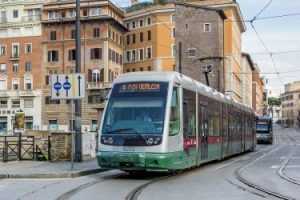 Systra Sotecni has won two of the five work packages launched as part of the Sustainable Urban Mobility Plan (SUMP) to revive some closed lines of Rome tram system. The contract covering a technical and economic feasibility study with an option for final and detailed design was won un a consortium with Systra S.A., Architecna Engineering, Go Mobility, VDP and Cooperativa Poleis.
Systra Sotecni has won two of the five work packages launched as part of the Sustainable Urban Mobility Plan (SUMP) to revive some closed lines of Rome tram system. The contract covering a technical and economic feasibility study with an option for final and detailed design was won un a consortium with Systra S.A., Architecna Engineering, Go Mobility, VDP and Cooperativa Poleis.
The work concerns the two largest lots in terms of assignments and value, representing three quarters of the new lines to be designed out of the 37.3 km planned in the SUMP. These are key sections for increasing the capacity of the network, as they are expected to carry 190,000 passengers per day out of the 250,000 per day expected for the completed network.
“Systra Sotecni is making a positive and significant contribution to the development of urban and sustainable transport in Italy, a commitment that will support the growing demand for mobility while limiting carbon emissions,” Luisa Bruzzone, Tender Office Manager of Systra Sotecni said.
Rome tram network comprises 6 lines totalling 40 km of track and 100 stations. The opening of new lines, interrupted since 1998, will resume with the implementation of the SUMP plan for urban and sustainable mobility.
Systra Sotecni will be working for Roma Servizi per la Mobilità, which is responsible for all studies, developments, creation, and management of mobility services locally on behalf of the special municipal authority Roma Capitale. The latter has awarded Systra Lots 4 and 5, the implementation of which will transform the attractiveness of public transport.
In the east of Rome, Lot 4 provides for the improvement of the service to a densely populated area through the creation of two new sections. One covers the extension of the future G line, enabling among others access to the Tor Vergata university campus and Città della Conoscenza, the Roman SIllicon Valley. The second section includes the construction of the new Line H with a length of 10 km.
Lot 5 concerns the construction of a 14.8 km tangential line to the south of Rome, with an expected ridership of 150,000 passengers/day, and will be interconnected with metro line B and the extension of tram line 14.
To create these new routes, particular attention will be paid to the archaeological heritage, to find the best possible insertion of the routes, especially for access to the Appia Antica regional park, one of the green lungs of the Italian capital, where, until now, 90% of the visitors go by car.
Share on:



